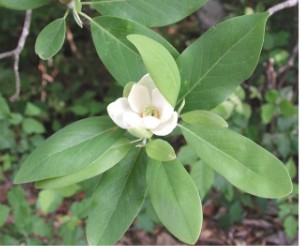Magnoliaceae facts for kids
Quick facts for kids Magnoliaceae |
|
|---|---|
 |
|
| Magnolia virginiana | |
| Scientific classification | |
| Kingdom: | |
| Division: | |
| Class: | |
| Order: | |
| Family: |
Magnoliaceae
|
The Magnoliaceae, also known as the Magnolia Family, is a group of beautiful flowering plants. This family belongs to the order Magnoliales. There are about 225 different types, or species, of plants in the Magnolia Family. These species are found in 7 main groups called genera.
Contents
The Amazing Magnolia Family
The Magnolia Family is one of the oldest groups of flowering plants on Earth. They have been around for millions of years! Scientists believe they existed even before bees evolved. This means their flowers were likely pollinated by beetles.
What Makes Magnolias Special?
Magnolia plants are known for their stunning flowers. These flowers often have large, showy petals. What makes them unique is that their petals and sepals (the green parts that protect the bud) often look the same. These are called tepals.
The flowers usually have many stamens (male parts) and carpels (female parts). These parts are arranged in a spiral shape, not in neat circles. This spiral arrangement is a sign of very old plant groups.
Magnolia leaves are usually simple and grow in an alternating pattern along the stem. Many species are trees or shrubs. Some are evergreen, keeping their leaves all year. Others are deciduous, meaning they lose their leaves in autumn.
Where Do Magnolias Grow?
Magnolia plants are found all over the world. They grow naturally in two main regions. One is eastern North America, Central America, and the West Indies. The other is East Asia and Southeast Asia.
They prefer temperate and tropical climates. This means they like places that are not too hot and not too cold. You can often find them in forests or gardens. Many types are popular ornamental plants. People love to plant them for their beautiful flowers.
How Magnolias Reproduce
Magnolias reproduce using their amazing flowers. The flowers produce pollen and seeds. As mentioned, beetles often help carry pollen from one flower to another. This process is called pollination.
After pollination, the flower develops into a fruit. This fruit is often cone-shaped. It contains the seeds. When the fruit ripens, it opens up. The seeds inside are often bright red or orange. They hang from the fruit by a small thread. Birds and other animals then help spread these seeds. This allows new magnolia plants to grow in different places.
Why Magnolias Are Important
Magnolias are important for several reasons. Their beautiful flowers make them very popular in gardens and parks. Many cities and towns plant magnolias to add beauty to the landscape.
Some magnolia species have been used in traditional medicine. For example, parts of certain magnolias are used in Chinese medicine. The wood from some magnolia trees is also used for furniture and other products. It is usually light and strong.
Magnolias also play a role in their ecosystems. They provide food and shelter for various animals. Their long history also makes them important for studying plant evolution. They help scientists understand how flowering plants developed over millions of years.
Images for kids
See also
 In Spanish: Magnoliáceas para niños
In Spanish: Magnoliáceas para niños


